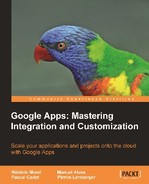This chapter discusses the security tools that come with Google Apps. The first section provides an overview of the main security components and explains how they are related: the antivirus filters, the spam filters, filter rules, the quarantine for suspicious messages, and the archiving facility. The next section then describes the security tools available to any Google Apps users and more specifically the console called the Message Center that provides secure access to quarantined messages and search tools. The final section goes into more detail to describe the main tasks that are the responsibility of a Google Apps domain administrator.
Safety for incoming mail, sent to recipients belonging to a Google Apps domain, or for outgoing mail, sent from that domain, is provided by a toolkit named the "Postini services". The name is that of a specialized start-up, which was acquired by Google in 2007. We can schematically group these tools in two categories: first the tools for ensuring the safety of messages and second, the tools for archiving and searching through the messages. Archiving tools are optional and in fact require a subscription in addition to a Google Apps for Business Edition subscription.
Among the many security features, the most important ones are the following:
- Content and attachment filters. This type of filter is generally designed to enforce a company's policy regarding incoming or outgoing messages.
- There are also TLS encryption mechanisms for secure inbound and outbound message exchange.
- Antivirus filters and anti-spam filters beyond the existing mechanisms in Gmail.
- A console called Message Center, which allows users to manage their own quarantined messages and define their own lists of approved or blocked addresses.
Among the features offered by the archiving tools let us mention:
- A centralized archiving facility for all emails of all users in a Google Apps domain.
- Monitoring tools and search tools.
- A personal archive that allows users to access their messages and to recover them as required.
Security and archiving tools are described schematically in the following figure. The filters dispatch suspect messages to quarantine where they can be read safely. A copy of each message that passed all filters is sent to the archive.

Incoming messages flow through antivirus and anti-spam filters. There are also filters that enforce policies on specific message content. Suspect messages are blocked and sent to quarantine. A similar pattern applies for outgoing mail and messages within a Google Apps domain.
Besides securing a Google Apps domain, Google Postini services also offer an interesting failover system named Google Message Continuity, for companies which choose to keep their Microsoft Exchange mail server.

Email flow diagram, when using Google Message Continuity
Google Message Continuity will ensure rapid failover in the event of a server outage. Email replication will automatically take place and users will be able to check their mail using Gmail in case of a failure of the on-premise mail system. Google Message Continuity actually includes all security features of Google Message Security and requires no hardware installation. It is managed through a simple web interface.
